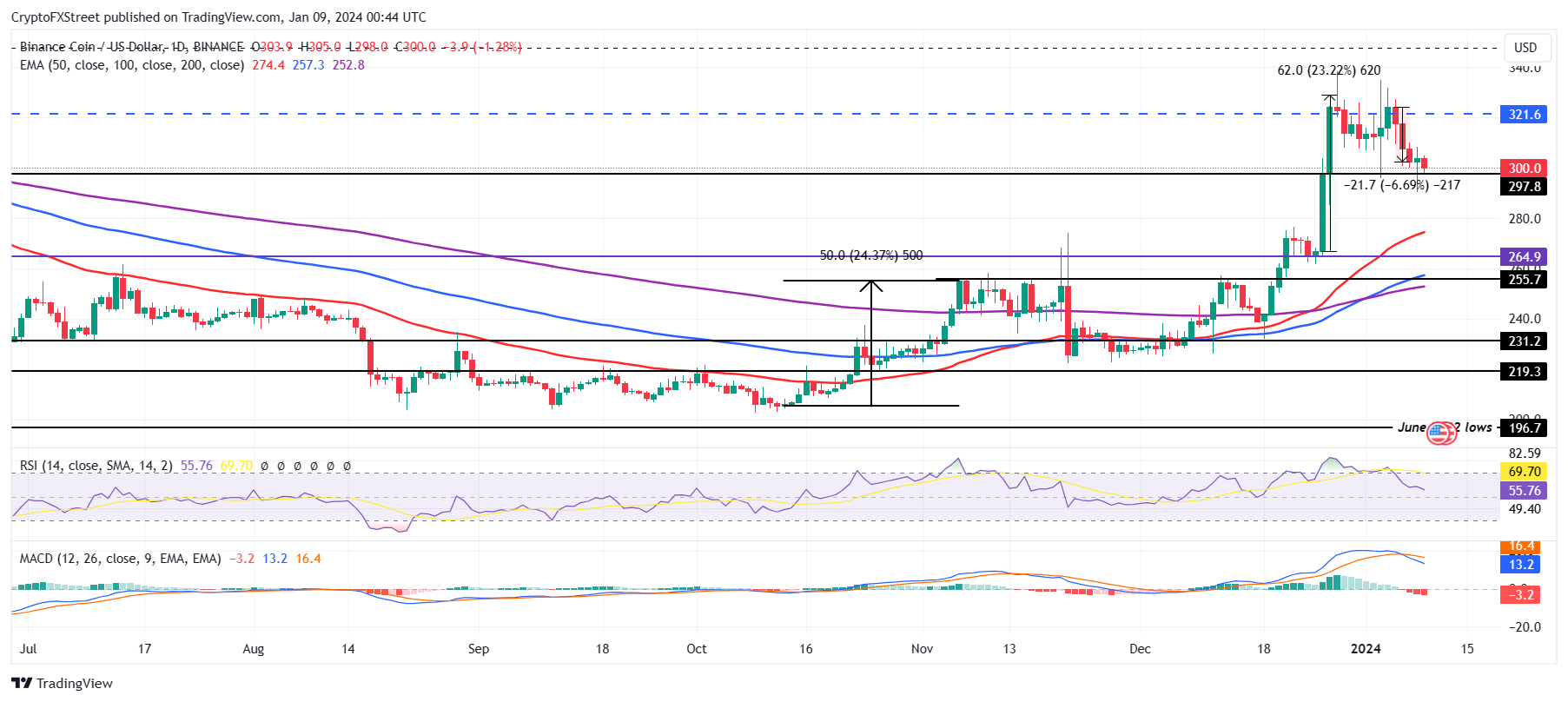Binance Coin price hovers around $300, unbothered by the potential spot Bitcoin ETF approval
- Binance Coin price noted a dip of almost 7% in the past four days to trade around the $300 mark.
- The spot Bitcoin ETF approval window is set within the next 48 hours, which will likely impact the market.
- If the flow of money is directed into BTC, BNB and other altcoins might see a dip over the coming days.
Binance Coin price reacted to the changing crypto market in a way that was both unexpected and surprising. The exchange token noted another slight dip, even as the rest of the market awaits the spot Bitcoin ETF approval from the Securities and Exchange Commission (SEC).
Binance Coin price sees a decline
Binance Coin price fell by a little over a percent in the past 24 hours to trade around the $300 mark. This decline added to the altcoin’s 6% correction from the past four days and brought the altcoin near a crucial support line of $297. This price point has been acting as a crucial support and resistance for BNB since the end of December after the 23% rally in 48 hours.
While price indicators remain bearish, it is important to talk about the potential impact of the approval of the spot BTC ETFs from the Securities and Exchange Commission (SEC). The highly anticipated event will act as a bullish catalyst for the altcoin, likely reversing the sentiment in the market.
Since neither the Relative Strength Index (RSI) nor Moving Average Convergence Divergence (MACD) are heavily bearish presently, the altcoin has a shot at recovery fuelled by the bullish broader market cues.

BNB/USD 1-day chart
However, if the funds flow out of the altcoin market and into BTC, BNB, along with other altcoins, could see a short-term correction, which might drag the exchange token below the $297 support line to test $280.
Cryptocurrency metrics FAQs
What is circulating supply?
The developer or creator of each cryptocurrency decides on the total number of tokens that can be minted or issued. Only a certain number of these assets can be minted by mining, staking or other mechanisms. This is defined by the algorithm of the underlying blockchain technology. Since its inception, a total of 19,445,656 BTCs have been mined, which is the circulating supply of Bitcoin. On the other hand, circulating supply can also be decreased via actions such as burning tokens, or mistakenly sending assets to addresses of other incompatible blockchains.
What is market capitalization?
Market capitalization is the result of multiplying the circulating supply of a certain asset by the asset’s current market value. For Bitcoin, the market capitalization at the beginning of August 2023 is above $570 billion, which is the result of the more than 19 million BTC in circulation multiplied by the Bitcoin price around $29,600.
What is trading volume?
Trading volume refers to the total number of tokens for a specific asset that has been transacted or exchanged between buyers and sellers within set trading hours, for example, 24 hours. It is used to gauge market sentiment, this metric combines all volumes on centralized exchanges and decentralized exchanges. Increasing trading volume often denotes the demand for a certain asset as more people are buying and selling the cryptocurrency.
What is funding rate?
Funding rates are a concept designed to encourage traders to take positions and ensure perpetual contract prices match spot markets. It defines a mechanism by exchanges to ensure that future prices and index prices periodic payments regularly converge. When the funding rate is positive, the price of the perpetual contract is higher than the mark price. This means traders who are bullish and have opened long positions pay traders who are in short positions. On the other hand, a negative funding rate means perpetual prices are below the mark price, and hence traders with short positions pay traders who have opened long positions.
